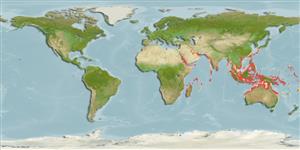Teleostei (teleosts) >
Gobiiformes (Gobies) >
Gobiidae (Gobies) > Gobiinae
Etymology: Amblyeleotris: Greek, amblys = darkness + The name of a Nile fish, eleotris (Ref. 45335); diagonalis: From the Latin 'diagonalis' referring to the oblique bands on the body.
Environment: milieu / climate zone / depth range / distribution range
Ecology
Marine; reef-associated; depth range 6 - 40 m (Ref. 48637). Tropical
Indo-Pacific: Kenya, Madagascar, Red Sea, Persian Gulf, Sri Lanka, Born Island, Andaman Sea; Guadalcanal, Solomons; Flores, Indonesia; south to the Great Barrier Reef.
Size / Weight / Age
Maturity: Lm ? range ? - ? cm
Max length : 11.0 cm SL male/unsexed; (Ref. 48637)
Dorsal spines (total): 7; Dorsal soft rays (total): 13; Anal spines: 1; Anal soft rays: 13. Characterized by whitish body color; snout and cheek with pair of thin, slanting dark brown bands, five wider brown bands on side with few brown spots between each band; anal fin yellow with blue margin; low basal membrane joins pelvic fins; predorsal scales extending forward to above posterior margin of preopercle; longitudinal scale series 67-75; greatest depth of body 5.2-6.7 in SL; caudal fin 2.8-3.6 in SL (Ref. 90102).
Lives with symbiont alpheid shrimps which prepare and maintain burrows in sand or sand and rubble areas (Ref. 9360). Found in coastal to outer reef sand slopes (Ref. 48637).
Life cycle and mating behavior
Maturity | Reproduction | Spawning | Eggs | Fecundity | Larvae
Randall, J.E. and M. Goren, 1993. A review of the gobioid fishes of the Maldives. Ichthyol. Bull. J.L.B. Smith Inst. Ichthyol. (58):1-37, 5 pls. (Ref. 9360)
IUCN Red List Status (Ref. 130435: Version 2024-2)
Threat to humans
Harmless
Human uses
Tools
Special reports
Download XML
Internet sources
Estimates based on models
Preferred temperature (Ref.
123201): 25 - 29.2, mean 28.2 °C (based on 956 cells).
Phylogenetic diversity index (Ref.
82804): PD
50 = 0.5000 [Uniqueness, from 0.5 = low to 2.0 = high].
Bayesian length-weight: a=0.00724 (0.00339 - 0.01546), b=3.10 (2.92 - 3.28), in cm total length, based on LWR estimates for this (Sub)family-body shape (Ref.
93245).
Trophic level (Ref.
69278): 3.4 ±0.4 se; based on size and trophs of closest relatives
Resilience (Ref.
120179): High, minimum population doubling time less than 15 months (Preliminary K or Fecundity.).
Fishing Vulnerability (Ref.
59153): Low vulnerability (10 of 100).
Nutrients (Ref.
124155): Calcium = 121 [54, 225] mg/100g; Iron = 0.713 [0.365, 1.368] mg/100g; Protein = 17.9 [15.9, 19.6] %; Omega3 = 0.0949 [, ] g/100g; Selenium = 26 [12, 56] μg/100g; VitaminA = 132 [35, 454] μg/100g; Zinc = 1.91 [1.24, 2.84] mg/100g (wet weight);
